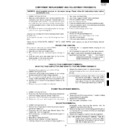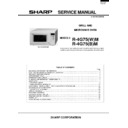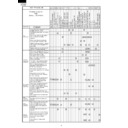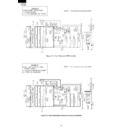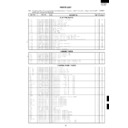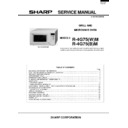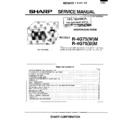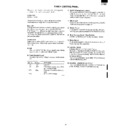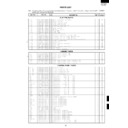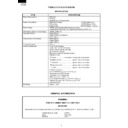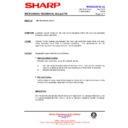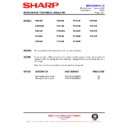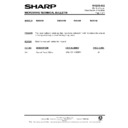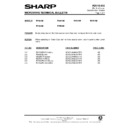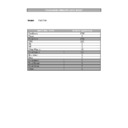Read Sharp R-4G75M (serv.man4) Service Manual online
23
R-4G75(W)M
R-4G75(B)M
R-4G75(B)M
COMPONENT REPLACEMENT AND ADJUSTMENT PROCEDURE
WARNING: Avoid possible exposure to microwave energy. Please follow the instructions below before
operating the oven.
transformer.
5. Remove the two (2) screws and one (1) washer holding
the transformer to base plate.
6. Remove the transformer.
7. Now, the power transformer is free.
7. Now, the power transformer is free.
1. Door does not close firmly.
2. Door hinge, support or latch hook is damaged.
3. The door gasket or seal is damaged.
4. The door is bent or warped.
5. There are defective parts in the door interlock system.
6. There are defective parts in the microwave generating
2. Door hinge, support or latch hook is damaged.
3. The door gasket or seal is damaged.
4. The door is bent or warped.
5. There are defective parts in the door interlock system.
6. There are defective parts in the microwave generating
and transmission assembly.
7. There is visible damage to the oven.
Do not operate the oven:
1. Without the RF gasket (Magnetron).
2. If the wave guide or oven cavity are not intact.
3. If the door is not closed.
4. If the outer case (cabinet) is not fitted.
1. Without the RF gasket (Magnetron).
2. If the wave guide or oven cavity are not intact.
3. If the door is not closed.
4. If the outer case (cabinet) is not fitted.
1. CARRY OUT 3D CHECKS.
2. Make sure that a definite "click" can be heard when the
2. Make sure that a definite "click" can be heard when the
microwave oven door is unlatched. (Hold the door in a
closed position with one hand, then push the door open
button with the other, this causes the latch heads to rise,
it is then possible to hear a "click" as the door switches
operate.)
closed position with one hand, then push the door open
button with the other, this causes the latch heads to rise,
it is then possible to hear a "click" as the door switches
operate.)
3. Visually check the door and cavity face plate for damage
(dents, cracks, signs of arcing etc.).
Carry out any remedial work that is necessary before oper-
ating the oven.
Do not operate the oven if any of the following conditions
exist;
ating the oven.
Do not operate the oven if any of the following conditions
exist;
Please refer to ‘OVEN PARTS, CABINET PARTS, DOOR PARTS’, when carrying out any of the following removal
procedures:
procedures:
OUTER CASE REMOVAL
To remove the outer case, proceed as follows.
1. Disconnect oven from power supply.
2. Open the oven door and wedge it open.
3. Remove the screws from rear and along the side edge of
1. Disconnect oven from power supply.
2. Open the oven door and wedge it open.
3. Remove the screws from rear and along the side edge of
case.
4. Slide the entire case back about 3cm to free it from
retaining clips on the cavity face plate.
5. Lift the entire case from the oven.
6. Discharge the H.V. capacitor before carrying out any
further work.
7. Do not operate the oven with the outer case removed.
N.B.; Step 1, 2 and 6 form the basis of the 3D checks.
N.B.; Step 1, 2 and 6 form the basis of the 3D checks.
CAUTION: DISCHARGE HIGH VOLTAGE
CAPACITOR BEFORE TOUCHING ANY
OVEN COMPONENTS OR WIRING.
OVEN COMPONENTS OR WIRING.
HIGH VOLTAGE COMPONENTS REMOVAL
(HIGH VOLTAGE CAPACITOR AND HIGH VOLTAGE RECTIFIER ASSEMBLY)
To remove the components, proceed as follows.
1. CARRY OUT 3D CHECKS
2. Disconnect all the leads and terminals of high voltage
2. Disconnect all the leads and terminals of high voltage
rectifier assembly from high voltage capacitor.
3. Remove one (1) screw holding earth side terminal of high
voltage rectifier assembly, and remove capacitor holder.
4. Remove one (1) screw holding capacitor holder to the
oven cavity.
5. Release the capacitor holder from the duct.
6. Remove the capacitor from the capacitor holder.
7. Now high voltage rectifier assembly and capacitor should
7. Now high voltage rectifier assembly and capacitor should
be free.
CAUTION: WHEN REPLACING HIGH VOLTAGE
RECTIFIER ASSEMBLY, ENSURE THAT
THE CATHODE (EARTH) CONNECTION IS
SECURELY FIXED TO THE CAPACITOR
HOLDER WITH AN EARTHING SCREW.
THE CATHODE (EARTH) CONNECTION IS
SECURELY FIXED TO THE CAPACITOR
HOLDER WITH AN EARTHING SCREW.
POWER TRANSFORMER REMOVAL
1. CARRY OUT 3D CHECKS
2. Disconnect the filament leads of the power transformer
2. Disconnect the filament leads of the power transformer
from high voltage capacitor and the magnetron.
3. Disconnect the H.V. wire A from the power transformer.
4. Disconnect the main wire harness from the power
4. Disconnect the main wire harness from the power
MAGNETRON REMOVAL
1. CARRY OUT 3D CHECKS.
2. Remove the air separate duct from the chassis support
2. Remove the air separate duct from the chassis support
and the air intake duct.
3. Disconnect the H.V. wire B and filament lead of the
transformer from the magnetron.
4. Remove the one (1) screw holding the chassis support to
the magnetron.
5. Move the air intake duct to left.
6. Remove the air deflector from the magnetron.
7. Carefully remove four (4) screws holding magnetron to
6. Remove the air deflector from the magnetron.
7. Carefully remove four (4) screws holding magnetron to
waveguide, when removing the screws hold the
magnetron to prevent it from falling.
magnetron to prevent it from falling.
8. Remove the magnetron from the waveguide with care so
that the magnetron antenna is not hit by any metal object
around the antenna.
around the antenna.
9. Remove the magnetron cushion from the magnetron.
CAUTION: WHEN REPLACING THE MAGNETRON, BE
SURE THE R.F. GASKET IS IN PLACE AND
THE MAGNETRON MOUNTING SCREWS
ARE TIGHTENED SECURELY.
THE MAGNETRON MOUNTING SCREWS
ARE TIGHTENED SECURELY.
24
R-4G75(W)M
R-4G75(B)M
R-4G75(B)M
FAN MOTOR REMOVAL
1. CARRY OUT 3D CHECKS
2. Remove the one (1) screw holding the noise filter to the
2. Remove the one (1) screw holding the noise filter to the
chassis support.
3. Release the noise filter from the tabs of the fan duct.
4. Disconnect the wire leads from the fan motor.
5. Remove the one (1) screw holding the capacitor holder
4. Disconnect the wire leads from the fan motor.
5. Remove the one (1) screw holding the capacitor holder
to the oven cavity back plate.
6. Remove the one (1) screw holding the fan duct to the oven
cavity back plate.
7. Release the tabs of the capacitor holder from the fan
duct.
8. Remove the fan duct from the oven.
9. Remove the fan blade assembly from the fan motor.
10.Remove the two (2) screws and two (2) nuts holding the
9. Remove the fan blade assembly from the fan motor.
10.Remove the two (2) screws and two (2) nuts holding the
fan motor to the fan duct.
11.Now, the fan motor is free.
CONTROL PANEL REMOVAL
1. CARRY OUT 3D CHECKS
2. Disconnect the main harness and stop switch harness
2. Disconnect the main harness and stop switch harness
from the control panel.
3. Remove the one (1) screw holding the control panel to the
oven cavity.
4. Lift up the control panel assembly and pull it forward.
Now, the control panel assembly is free.
TURNTABLE MOTOR REMOVAL
4. Disconnect the wire lead from turntable motor and remove
the 2 screws holding the turntable motor.
5. Turntable is now free.
6. After replacement use the one (1) screw allocated to fit
6. After replacement use the one (1) screw allocated to fit
the TT motor cover.
1. Disconnect the oven from power supply.
2. Remove the turntable motor cover by snipping of material
2. Remove the turntable motor cover by snipping of material
in four corners.
3. Where the corners have been snipped off bend corner
areas flat. No sharp edge must be evident after removal
of TT motor cover.
of TT motor cover.
TURNTABLE COUPLING REMOVAL
1. Remove the turntable motor, refer to “Turntable Motor
Removal”.
2. Remove the two (2) screws holding the turntable motor
support angle to the oven cavity.
3. Remove the turntable motor support angle from the oven
cavity.
4. Pull the coupling out of the hole in the oven cavity.
5. At that time the turntable coupling will be free.
5. At that time the turntable coupling will be free.
PACKING
Figure C-1. Turntable Coupling
OVEN LAMP SOCKET REMOVAL
1. CARRY OUT 3D CHECKS
2. Pull the wire leads from the oven lamp socket by pushing
2. Pull the wire leads from the oven lamp socket by pushing
the terminal hole of the oven lamp socket with the flat type
small screw driver.
small screw driver.
3. Lift up the oven lamp socket.
4. Now, the oven lamp socket is free.
4. Now, the oven lamp socket is free.
Figure C-2. Oven lamp socket
Oven lamp socket
Terminal
Wire lead
Flat type
small screw
driver
small screw
driver
Terminal hole
1. CARRY OUT 3D CHECKS.
2. Remove the one (1) screw holding the exhaust duct to the
2. Remove the one (1) screw holding the exhaust duct to the
oven cavity.
3. Remove the exhaust duct from the oven cavity.
4. Disconnect the wire leads from the grill heating elements.
5. Lay down the two (2) tabs holding the heater reflector to
4. Disconnect the wire leads from the grill heating elements.
5. Lay down the two (2) tabs holding the heater reflector to
the oven cavity.
6. Remove the heater reflector from the oven cavity by
sliding it toward the magnetron.
GRILL HEATING ELEMENTS REMOVAL
7. Make the tabs of grill heater angle straight.
8. Remove the grill heater angle, grill heating elements and
8. Remove the grill heater angle, grill heating elements and
the short terminal together from the heater reflector.
9. Remove the grill heater angle from the grill heating
elements.
10.Remove the two (2) screws holding the short terminal to
the grill heating elements.
11.Now, the grill heating elements are free.
COUPLING
25
R-4G75(W)M
R-4G75(B)M
R-4G75(B)M
POWER SUPPLY CORD REPLACEMENT
Removal
1. CARRY OUT 3D CHECKS.
2. Remove the single (1) screw holding the green/yellow
1. CARRY OUT 3D CHECKS.
2. Remove the single (1) screw holding the green/yellow
wire to the chassis support.
3. Disconnect the leads of the power supply cord from the
noise filter, referring to the Figure C-3 (a).
4. Release the power supply cord from the rear cabinet.
5. Now, the power supply cord is free.
5. Now, the power supply cord is free.
Re-install
1. Insert the moulding cord stopper of power supply cord
1. Insert the moulding cord stopper of power supply cord
into the square hole of the rear cabinet, referring to the
Figure C-3 (b).
Figure C-3 (b).
2. Install the earth wire lead of power supply cord and the
earth angle to the chassis support with one (1) screw and
tight the screw.
tight the screw.
3. Connect the brown and blue wire leads of power supply
cord to the noise filter correctly, referring to the Pictorial
Diagram.
Diagram.
OVEN CAVITY
BACK PLATE
BACK PLATE
BROWN WIRE
NOISE FILTER
POWER SUPPLY CORD
BLUE WIRE
CHASSIS SUPPORT
POWER SUPPLY
CORD
CORD
MOULDING
CORD
STOPPER
CORD
STOPPER
OVEN CAVITY
BACK PLATE
BACK PLATE
SQUARE HOLE
Figure C-3 (a) Replacement of Power Supply Cord
Figure C-3 (b) Replacement of Power Supply Cord
If the primary latch switch, 2nd. latch switch, stop switch and
monitor switch do not operate properly due to a mis-adjust-
ment, the following adjustment should be made.
1. CARRY OUT 3D CHECKS
2. Loosen the two (2) screws holding the latch hook to the
monitor switch do not operate properly due to a mis-adjust-
ment, the following adjustment should be made.
1. CARRY OUT 3D CHECKS
2. Loosen the two (2) screws holding the latch hook to the
PRIMARY LATCH SWITCH, 2ND LATCH SWITCH, STOP SWITCH AND MONITOR SWITCH ADJUSTMENT
AH SENSOR ASSEMBLY REMOVAL
1. CARRY OUT 3D CHECKS.
2. Disconnect the connector CN-F of the AH sensor assembly
2. Disconnect the connector CN-F of the AH sensor assembly
from the control unit.
3. Release the snap band of the AH sensor assembly from
the control unit.
4. Remove the wire tie holding the AH sensor cable to main
wire harness.
5. Remove the two (2) screws holding the AH sensor
assembly to the exhaust duct assembly.
6. Now, the AH sensor assembly is free.
PRIMARY LATCH SWITCH, 2ND LATCH SWITCH, STOP SWITCH AND MONITOR SWITCH REMOVAL
1. CARRY OUT 3D CHECKS.
2. Remove the control panel assembly referring to
2. Remove the control panel assembly referring to
“CONTROL PANEL REMOVAL”.
3. Disconnect the leads from all switches.
4. Remove the two (2) screws holding the latch hook to the
4. Remove the two (2) screws holding the latch hook to the
oven cavity.
5. Remove the latch hook.
6. Push the retaining tab slightly and remove the switch.
6. Push the retaining tab slightly and remove the switch.
2ND LATCH
SWITCH
SWITCH
TAB
MONITOR
SWITCH
SWITCH
STOP
SWITCH
SWITCH
TAB
PRIMARY
LATCH
SWITCH
LATCH
SWITCH
Figure C-4. Switches
oven cavity front flange.
3. With door closed, adjust the latch hook by moving it back
and forward, or up and down. In and out play of the door
allowed by the latch hook should be less than 0.5 mm.
The horizontal position of the latch hook should be placed
allowed by the latch hook should be less than 0.5 mm.
The horizontal position of the latch hook should be placed
26
R-4G75(W)M
R-4G75(B)M
R-4G75(B)M
where the monitor switch and 2nd latch switch have
activated with the door closed. The vertical position of the
latch hook should be placed where the primary latch
switch and stop switch have activated with the door
closed.
activated with the door closed. The vertical position of the
latch hook should be placed where the primary latch
switch and stop switch have activated with the door
closed.
4. Secure the screws with washers firmly.
5. Make sure of the primary, 2nd latch switch, stop switch
5. Make sure of the primary, 2nd latch switch, stop switch
and monitor switch operation. If those switches have not
activated with the door closed, two (2) screws holding
latch hook to oven cavity front flange and adjust the latch
hook position.
activated with the door closed, two (2) screws holding
latch hook to oven cavity front flange and adjust the latch
hook position.
After adjustment, make sure of following:
1. In and out play of door remains less than 0.5 mm when
1. In and out play of door remains less than 0.5 mm when
latched position. First check latch hook position, pushing
and pulling the door toward the oven face. The results
(play of the door) should be less than 0.5 mm.
and pulling the door toward the oven face. The results
(play of the door) should be less than 0.5 mm.
2. The contacts (COM - NO) of primary latch switch and stop
switch interrupt the circuit before the door can be opened.
3. The contacts (COM - NC) of the monitor switch close
when the door is opened.
4. The contacts (COM - NO) of the 2nd latch switch open
when the door is opened.
5. Re-install outer case and check for microwave leakage
around the door with an approved microwave survey
meter. (Refer to Microwave Measurement Procedure.)
meter. (Refer to Microwave Measurement Procedure.)
LATCH HOOK
DOOR
2ND LATCH
SWITCH
SWITCH
STOP
SWITCH
SWITCH
MONITOR
SWITCH
SWITCH
PRIMARY LATCH
SWITCH
SWITCH
OPEN LEVER
DOOR OPEN BUTTON
LATCH
HEADS
HEADS
Figure C-5 Latch Switches Adjustment
DOOR FRAME AND SCREEN REMOVAL
Remove the door assembly, referring to from item 1 through
item 4 of “DOOR REPLACEMENT”.
1. Place the door assembly on a soft cloth with facing up.
2. Remove the choke cover, referring to “CHOKE COVER
item 4 of “DOOR REPLACEMENT”.
1. Place the door assembly on a soft cloth with facing up.
2. Remove the choke cover, referring to “CHOKE COVER
REMOVAL”.
3. Remove the four (4) screws holding the door frame to the
door panel assembly.
4. Release the door frame from the door panel assembly,
now the door frame is free.
5. Gently lever the door screen from the door frame, taking
care not to scratch the door screen.
6. Replace tape and secure frame screen.
DOOR REPLACEMENT AND ADJUSTMENT
DOOR REPLACEMENT
1. CARRY OUT 3D CHECKS
2. Remove five (5) screws holding the upper and lower oven
1. CARRY OUT 3D CHECKS
2. Remove five (5) screws holding the upper and lower oven
hinge to the oven cavity. The lower oven hinge is now
free.
free.
3. Remove door assembly with upper oven hinge by pulling
it forward.
4. Separate the door assembly and upper oven hinge. Door
assembly is now free.
5. Re-install upper oven hinge to the new door assembly.
6. On re-installing new door assembly, secure the upper
6. On re-installing new door assembly, secure the upper
and lower oven hinges with the five (5) mounting screws
to the oven cavity. Make sure the door is parallel with
bottom line of the oven face plate and the latch head pass
through the latch holes correctly.
to the oven cavity. Make sure the door is parallel with
bottom line of the oven face plate and the latch head pass
through the latch holes correctly.
7. CARRY OUT 4R CHECKS
Note:
Note:
After any service to the door, the approved microwave
survey meter should be used to assure in compliance
with proper microwave radiation standards. (Refer
to Microwave Measurement Procedure.)
survey meter should be used to assure in compliance
with proper microwave radiation standards. (Refer
to Microwave Measurement Procedure.)
DOOR ADJUSTMENT
When removing and/or loosening hinges such as in door
replacement, the following adjustment criteria are taken.
Door is adjusted to meet the following three conditions by
keeping screws of hinge loose.
1. Adjust door latch heads at a position where they smoothly
When removing and/or loosening hinges such as in door
replacement, the following adjustment criteria are taken.
Door is adjusted to meet the following three conditions by
keeping screws of hinge loose.
1. Adjust door latch heads at a position where they smoothly
catch the latch hook through the latch holes. Refer to
latch switch adjustments.
latch switch adjustments.
2. Deviation of the door alignment from horizontal line of
cavity face plate is to be less than 1.0mm.
3. The door is positioned with its face depressed toward the
cavity face plate.
4. Reinstall outer case and check for microwave leakage
around the door with an approved microwave survey
meter. (Refer to Microwave Measurement Procedure.)
meter. (Refer to Microwave Measurement Procedure.)
LATCH HEAD REMOVAL
1. Insert an iron plate(thickness of about 0.5mm)
2. Release the latch spring from the tabs of the door panel.
3. Release the latch spring from the latch head.
4. Release the latch head from the door panel.
5. Now, the latch head is free.
1. Insert an iron plate(thickness of about 0.5mm)
2. Release the latch spring from the tabs of the door panel.
3. Release the latch spring from the latch head.
4. Release the latch head from the door panel.
5. Now, the latch head is free.
DOOR ASSEMBLY
UPPER OVEN
HINGE
HINGE
RE-INSTALL
LATCH HEAD
LOWER
OVEN HINGE
OVEN HINGE
Figure C-6. Door Assembly Replacement
and Adjustment

